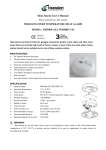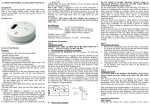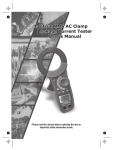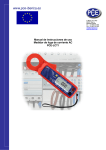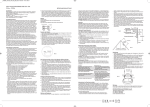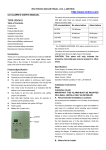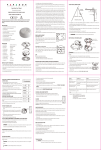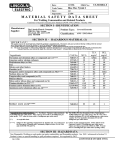Download CO ALARM'S USER'S MANUAL
Transcript
Recommended Installation Locations: CO ALARM USER’S MANUAL Model No: GS804 Thank you for purchasing the GS804 carbon monoxide alarm. Please take a few minutes to thoroughly read the user’s guide and familiarize yourself and your family with its operation. And save for future reference. Installation Instructions: Installation Location When choosing your installation locations, make sure you can hear the alarm from all sleeping areas. If you install only one carbon monoxide alarm in your home, install the alarm near bedrooms, not in the basement or furnace room. Caution This alarm must be mounted on a ceiling or wall. Mounting step Please refer to sketch map: picture 2 1: Mark the proper location on the wall or ceiling, according to the two holes of the bracket of alarm. 2: Drill two ф5.0mm holes in the ceiling or wall, then insert two plastic plugs into the holes. 3: Attach the bracket to the plastic plugs and fix tightly the screws into the plastic plugs. 4: Fit the alarm on the bracket and turn the alarm body clockwise, until matching well on the bracket. 5: After installing or replacing the battery, reinstall your alarm. Test your alarm by using the test button and check that the green LED flashing about every 30 seconds. As you install the battery on the unit, maybe it will sound for several minutes, then stop and enter normal operation mode. If it always sounds, please call our agent. The following suggestions are intended to help you with the placement and installation of your alarm. 1: Place out of the reach for children. Under no circumstance should children be allowed to handle the alarm. 2: Install in a bedroom or hallway located close to the sleeping area. Take special care to verify the alarm can be heard in sleeping areas. 3: It is recommended that a alarm be installed on each level of a multilevel home. 4: Locate at least 5 feet away from all fuel burning appliances. 5: Placing at eye level allows for optimum monitoring of the red and green indicator lights. · 6: Insure that all vents of the unit are unobstructed. 7: Do not install in dead air spaces such as peaks of vaulted ceilings or gabled roofs. 8: Do not install in turbulent air from ceiling fans. 9: Do not place near fresh air vents or close to doors and windows that open to the outside. 10: Keep the alarm away from excessively dusty, dirty, or greasy areas such as kitchens, garages and furnace rooms. Dust, grease and household chemicals can affect the sensor. 11: Keep out of damp and humid areas such as the bath room. Avoid spraying aerosols near the alarm. 12: Do not install in areas where the temperature is below 4℃ or hotter than 38℃ 13: Do not place behind curtains or furniture. Carbon monoxide must be able to reach the sensor for the unit to accurately detect carbon monoxide. LED Indicator Light: 1: If a dangerous level of carbon monoxide is detected, the red alarm LED will flash continuously and the alarm will sound, until carbon monoxide is eliminated. 2: If battery failure or low battery is detected, the alarm will “chirp” one time and with a corresponding green LED flashing one time per 30 seconds. 3: If the alarm is running normally, green LED will flash one time per 30 seconds. Test/Hush Button: The test/hush button is used to test the unit’s electronics and to hush the unit during alarm. TEST THE UNIT To test, press the test/hush button, you will hear sound continuously and with a corresponding red LED flashing until releasing the test/hush button. Note: Test the unit weekly! If at any time your unit does not perform as described, please replace it immediately. Note: After the test/hush button is pressed, the alarm sounds and the red alarm light flashes. This does not indicate that carbon monoxide is present. Note: Allow you to test the sensor by blowing a little smoke into the detector. HUSH THE ALARM If the alarm is sounding, pressing the test/hush button will stop the alarm for about 5 minutes. But, during 5 minutes, if the co concentration is more than 150ppm, it will alarm within 2 minutes. Battery Installation/Replacement: One “chirp” about 30 seconds is an indication that the battery is low, you must replace the battery, please see “Battery specifications”. To install or replace the battery in unit, please perform the following steps: 1. Turn the alarm body counterclockwise and take out alarm body; 2. Make the power input connector connected to the new battery (see picture 1 ); 3. The green LED indicator light will flash one time, every 30 seconds; 4: Put the battery into the battery box; 5: Fit alarm body on bracket and turn the alarm body clockwise; 6: Test alarm using test/hush button. The horn pattern is BI 0.5s - pause 0.5s – BI 0.5s – pause 0.5s – BI 0.5s – pause 1.5s, with a corresponding LED flashing, repeat this alarm pattern. If it has no this action, indicating the alarm is bad or the installing operation is wrong, and you should contact us for gaining the correct method of disposal. WARNING! Use only the batteries specified. Use different batteries may have detrimental effects on the alarm. A good safety measure is to replace the battery at least once a year. Note: Reinstall immediately after cleaning and then test unit using the test/hush button. What to Do If the Alarm Sounds: WARNING! –Action of this device indicates the presence of dangerous levels of carbon monoxide! Carbon monoxide can be fatal! If the alarm sounds: 1: Operate the test/hush button; 2: Shut down furnaces and gas supply; 3: Immediately move to fresh air-outdoor or by an open door/window. Do a head count to check that all persons are accounted for. Do not reenter the premises nor move away from the open door/window until the emergency services responders arrive, the premises have been aired out, and your alarm remains its normal condition. 4: After following steps 1-3, if your alarm reactivates within a 24 hour period, repeat steps 1-3 and call a qualified appliance technician to investigate for sources of carbon monoxide from fuel burning equipment and appliances and inspect for proper operation of this equipment, if problems are identified during this inspection, please have the equipment serviced immediately. Note any combustion equipment not inspected by the technician and consult the manufacturer’s instructions or contact the manufacturer directly for more information about carbon monoxide safety and this equipment. Make sure that motor vehicles are not or have not been operating in an attached garage or adjacent to the residence. Specification: POWER: DC 9V battery operated ALARM SENSITIVITY: 100±50PPM STANDBY CURRENT: <30µA ALARM CURRENT: <40mA OPERATION AMBIENT CONDITION: 4~38℃, 25~85%R.H. SENSOR TYPE: Electrochemical BATTERY SPECIFICATIONS: Rating voltage: DC 9V Package: Carbon Zinc 6F22 or Alkaline 6Lr61, 1604A for ANSI, 6AM6 for JIS. Size: 25.5 * 16.5 * 47.5 (unit: mm), it is approximation. ALARM VOLUME: ≥85DB at 100cm @3.4±0.5KHz pulsing alarm (The alarm sound pattern: BI 0.5s - pause 0.5s – BI 0.5s – pause 0.5s – BI 0.5s – pause 1.5s, with a corresponding LED flash, repeat this alarm pattern) RECOMMEND BATTERY TYPE: G6F22 (GOLD POWER) Note: This carbon monoxide alarm is designed to detect carbon monoxide gas from any source of combustion. It is not designed to detect any other gases. General Maintenance: To keep your alarm in a good working order, please follow these simple steps: 1: Verify the alarm and LED lights operation by pushing the test/hush button once a week. 2: Remove the unit from mounting bracket and clean the alarm cover and vents with a soft brush attachment once a month to remove dust and dirt. 3: Never use detergents or other solvents to clean the unit. 4: Avoid spraying air fresheners, hair spray, or other aerosols near the alarm. 5: Do not paint the unit. Paint will seal the vents and interfere with the sensor's ability to detect carbon monoxide. Never attempt to disassemble the unit or clean inside. This action will void your warranty. 6: As soon as possible, place the alarm back in its proper location to assure continuous protection from carbon monoxide poisoning. 7: When household cleaning supplies or similar contaminants are used, the area should be ventilated. Warning: The following substances can affect the sensor and cause false readings: Methane, propane, isobutene, isopropanol, ethylene, benzene, toluene, ethyl acetate, hydrogen sulfide, sulfur dioxides, alcohol based products, paints, thinner, solvents, adhesives ,hair sprays, after shaves ,perfumes and some cleaning agents. Warning: Your CO alarm will not be operational and will not monitor for CO levels without the battery. Warning: This apparatus is designed to protect individuals from the acute effects of carbon monoxide exposure. It will not fully safeguard individuals with specific medical conditions. if in doubt consult a medical practitioner. Carbon Monoxide overview: Carbon monoxide cannot be seen, smelt or tasted but can be fatal. The build up of carbon monoxide in the blood is called the carboxyhemoglobin level and interferes with the body’s ability to supply itself with oxygen. Depending on the concentration of carbon monoxide, it can kill in minutes. The most common sources of carbon monoxide are malfunctioning gas appliance used for heating and cooking ,vehicles running in an attached garage, blocked chimneys or flues, portable fuel burning heaters, fireplaces, fuel powered tools and operating a grill in an enclosed space. Indications of carbon monoxide poisoning include symptoms similar to the flu, but with no fever. Other symptoms include dizziness, fatigue, weakness, headache, nausea, vomiting, sleepiness and confusion. Everyone is susceptible to the danger of carbon monoxide, but experts agree that unborn babies, small children, pregnant women, senior citizens and people with heart or respiratory problems are at the highest risk for serious injury or death, each year a qualified technician should inspect and clean your heating system, vents, chimney, and flues. The following symptoms are related to CARBON MONOXIDE POISONING and should be discussed with ALL members of the household: 1. Slight Symptom: Slight headache, nausea, vomiting, fatigue (often described as "Flu-like" symptoms). 2. Medium Symptom: Severe throbbing headache, drowsiness, fast heat rate. 3. Serious Symptom: Unconsciousness, cardiorespiratory, failure, death . The above levels of exposure relate to healthy adults. Levels differ for those at high risk. Exposure to high levels of carbon monoxide can be fatal or cause permanent damage and disabilities. Many cases of reported carbon monoxide poisoning indicate that while victims are aware they are not well, they become so disoriented they are unable to save themselves by either exiting the building, or calling for assistance. Also, young children and household pets may be the first effected. Familiarization with the effects of each level is important. Product Overview: Bicolor LED indicator light Alarm body Picture 1 Holes of ceiling or wall Plastic plug Bracket two screws Test/Hush button Battery box www.global-export-import.eu Picture 2




